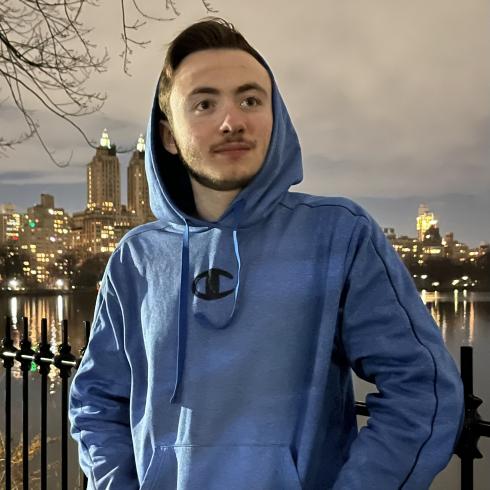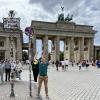On July 27, 2024, I woke up in total disbelief. After a two-month journey in Berlin, today was the day when I was going to close this chapter of my life. I checked out of my hotel, which had begun to feel more like a home than a temporary place to live. I boarded the S-Bahn 9 (a local train) all the way to the airport and had a brief conversation with a friend of mine dazed from the fun night we had shared yesterday. We had been at the farewell dinner, before going back to play some Ping Pong. I wish I could remember more of that conversation but I was so brain dead that I went to sleep on the plane: it was like the whole conversation disappeared from my memory. It was the last conversation I would have with anybody in IES Abroad before touching down in America. It was the last time I would see anybody from my summer in Berlin for the foreseeable future. We had come together for the summer as strangers, before scattering across the United States like a game of 52 pickup.
That’s the hard part about going abroad. As I embraced the arms of my family and friends after my long journey, there was a sense of alienation. I had been ripped out of my way of life last May to a whole new one, before I was just as abruptly ripped away and put back where I came from. Everybody in my hometown was saying the same things and cracking the same jokes, yet I felt different. I had this memory of two months that nobody around me could understand fully. It was uniquely mine and hard to compartmentalize.
It felt like the soundest place to visit for an idea of this summer was the data I had been collecting for this blog. Over the course of 62 days, from the day I left to the day I returned, I have a complete telling of my summer in Berlin. I tracked three data points: happiness, money, and time. There was no hypothesis for any of what I would eventually discover. While I will add some comments and insights, it is ultimately up to you for how you would like to interpret the data. I can offer my opinions, but the charts you are about to see are the facts of the matter. That’s the beauty in numbers. They are unbiased in a way that humans can’t be.

My happiness was rated on a scale of three, the best possible score of a day, to negative three, the worst possible score. In the middle is zero, a neutral day. For example, I gave June 30th a three because I spent the day with a high school friend that I had drifted apart with since going to separate universities. So, being able to reconnect and spend the day going to the Charlottenburg Palace, Biergarten, and fanzone to watch the Euros was awesome. Meanwhile, a day like July 15th was given a negative three because despite needing to get things done for my internship, I spent over four hours procrastinating before giving up on the day and going to bed. If there’s anything I hated, it was wasting one of 62 days of my summer in Berlin.
The graph illustrates a jagged collection of peaks and valleys, rising and falling at seemingly random points. At first, Berlin was a fever dream for me and I scored highly before my internship began and I had to get to work. After gaining my rhythm, I underwent a series of remarkably consistent good vibes. The highlight of which was a 19-day streak where not a single day was rated negatively from June 19th to July 7th. The following weeks were also consistently good, as I did well on my promise to travel outside of Berlin during the month of July. If the day was rated a three, chances are that I traveled somewhere in Europe. However, Berlin itself was still producing some gems of its own. July 16th was rated a two after I rebounded from the disastrous day prior and got lots of work completed. The score difference is five, the largest between any two days.
It’s hard to tell at a glance but one thing I enjoyed about my happiness score was that it continued to rise as time went on. The first 31 days in Berlin had an average score of 1.13, while the following 31 averaged 1.26. I was still enjoying myself even by the end of my time here because there was still so much that I wanted to do. It got to the point that on my to-do list, I had to start making cuts because I realized just how little time I had remaining to get everything done on my list. It’s why on my final full day in Berlin, I went up to the top of the TV Tower in the afternoon. After passing by it for the last two months and using it as a “North Star” to get back to my hotel nearby, my curiosity got the better of me. From the top, I had a cathartic moment as I looked out at the city I had been exploring like a rat in a maze. Yet, it’s funny because for all the places that I acknowledged myself going to, there were just as many that I didn’t. There was still more to do but that was ok. I was content with myself and most of all, happy.

While the bigger number the better for happiness on the happiness graph, money could not have been any different. This chart shows the graduate increase of my bank account dwindling down. For as much as I would love to talk about how happy I was on this trip, there is also the cost to my journey. While others in my program chose to ignore this fact and deal with the consequences once they were back in America, I tried to find a natural balance between having fun while also doing so responsibly. It was the less glamorous side to all of this but just as important as the other two categories. By July 27th, all the memories to come out of this summer came at a price of $2,738.34 (This is not including pre-departure fees, such as cost of the program or airfare which can vary wildly for any one person).
At a glance, that figure may seem like a lot but the way I like to think about it is how much money is worth to my happiness. If I could pay $2,738.34 later in my life to again be as happy as I was this summer, I’m sure I would take that deal. Meanwhile, I would have had to opt out of this hypothetical when I was 12 years old because that amount of money was more than I had in my entire life up to that point. Money and its cost is relative to each person depending on their stage of lives. For me, I felt like this amount of money was a good deal. I’ll make plenty of money in my lifetime. Right now, I’m all about making memories while I’m young and have the time to. It was hard to stomach a day like July 20th while I was in Amsterdam, when I spent $373.07. This included the hostel and bus fees, museums like the Rijksmuseum, and then food like the Stroopwaffel. Interestingly while July 20th put a dent in my wallet, it also put a hurtin’ on my feet. I took 41,865 steps, what might very likely have been the most foot-pounding day of my life.
The easiest way to reduce the figure is to simply not travel. In the month of July, I traveled to Kraków, Nuremberg, Munich, Hamburg, and Amsterdam. This is where the apparent bump in the graph comes from. Between those 5 cities, I spent $1,071.05. I was able to save some money by taking long buses between cities, buying cheap street food, and staying in hostels where I shared a room with multiple other travelers. Though, the most cost effective of things I did was sleep overnight on Flix buses using my neck pillow to at least get some sleep. Then, I would wake up at my destination, drink a cup of coffee, and be ready to explore. For me, eating, sleeping, and transportation were all secondary. What I cared about were the experiences. In that grand are the memories of 10 of the most novel days of my life. I saw the Wawel Castle in Kraków, the courtroom for the Nuremberg Trials at the end of WWII, BMW Museum in Munich, Miniatur Wunderland in Hamburg, and Van Gogh Museum in Amsterdam.

Time while in Berlin was broken up into 15 minute blocks, as I methodically recorded what I was doing each hour. It’s not a perfect system but is still accurate enough to visualize the broad strokes of how I spent my days in Berlin, broken up into nine categories that I have outlined in my previous blog. If you would like to hear more insights about the methodology to this, other topics related to time, or any of the other previous categories, feel free to look back on the respective blogs. As for the graph itself, I aggregated the days into weeks for the sake of neatness, as having 62 lines with different colors made my computer look like it was glitching out. As for when the day of the week starts, I chose Monday out of respect for how they do things in Europe, the superior convention for the first day of the week for how it does not break up the end of the weekend into two separate weeks like we do in the states.
During my first week, I was super social (represented by pink), having conversations with anybody and everybody who would listen to me. I was a certified “yapper,” trying to put myself out there so I could make friends as quickly and seamlessly as possible. It felt like freshman orientation again but in a good way. Then, once internships started up (represented by the green and blue bars at the bottom), the social time decreased. It had a large drought during weeks six and seven, the heart of my time traveling across Europe. I don’t think I mind that fact, as time away from others made me appreciate them more when I eventually saw them and gave me a lot of time to soak things in on my own like I elaborated on in my previous blog.
One somewhat unsettling fact about as the weeks went a lot was with how that red sliver (which represents procrastinating) became larger and larger as time went on. I think despite loving Berlin, I sometimes had a difficulty focusing during the time I needed to be doing internship work. There was a sense of burnout brewing, as this was the first time I didn’t have a break between work. During traditional semesters at my university, we have either a summer or winter break for me to be rejuvenated from. There was none of that between my spring semester and this experience, which felt like it was taking its toll as it felt like an extra long semester at times. The work continued to get more complex as expectations rose and I started to lose steam. Thankfully, I finished my internship strongly, proven by a presentation on the data insights I found on migrant entrepreneurship (Similar to what I am doing here).

The following three categories provide lots of insights but a simple trick in Data Science to gain even more insight from data is to combine it all. This is where the magic happens and truly where the fruits of collecting all this data are prevalent. The image above is a bubble chart, distinctive from its points of data which vary in size. While a scatter plot (a closely related chart to the bubble) has uniform sized points, a bubble chart is great in adding more detail by using the magnitude of points as a third variable. In essence, it is useful when you want to show the relationship between two variables while also conveying the magnitude of a third. So in the case of this bubble chart, we are measuring happiness score versus money spent each day, with the magnitude of the bubbles representing how many instances there were of that happiness score. The happiness score data worked out to conveniently have instances of every possible score, with a good mix from negative one to three. This is why those bubbles appear as large as they do. Meanwhile, bubbles for negative two and negative three are noticeably tiny since there is only one case of either one of those scores.
With the graph, a strong, positive correlation is present between happiness and how much money I spent each day. As I spent more money, I expected to be happy yet and, for the most part, it was true. Perhaps subconsciously when I was going to bed, I was going to be more favorable towards days where I know I spent a lot of money because money implied that I did a lot that day. This however, does not remain true for our two outliers in negative two and negative three. While negative one to three have an increased spending with each higher score, negative two breaks this trend by being slightly higher than negative one at $22.06 compared to $19.53. Meanwhile, negative three breaks this chart’s trend dramatically with its average spending of $51.42, higher than two’s spending of $50.86.
However, context matters. Negative three and negative two, as previously mentioned, only have one instance each. For June 3rd, rated negative two, most of the spending was from groceries while on July 15th, rated negative three, that spending was entirely groceries. Grocery shopping, while costly, is the spending for that day and many subsequent days. Even though the burden falls on the day it was purchased, other days are benefitted from that spending. So, it is fair to say that it doesn’t entirely count as spending for that day which continues to support the argument that at least in my case, money did seem to indeed buy me happiness.

With the bubble chart understood, this next one should look familiar. It follows the exact same structure, with the only difference being money swapped out for hours of social time. So, the question this chart tries to answer is that does being social equate to happiness? As it turns out in my case, yes it does. Each average happiness score continues to increase at varying levels. For the case between zero and negative one, it is almost negligible but there is an increase of 0.012 hours of happiness. Then on the lower extreme of things, I spent exactly 15 minutes socializing which included texting some friends when I woke up, interactions which were not even face-to-face. As for the upper extreme, I was spending 9.11 hours socializing on average.
While some might anticipate going abroad more of a self exploration of one’s self, I found those human connections to be so precious. Most of my best memories involved being around people whether it was watching a soccer game or going out together at night. It was where all the inside jokes spawned and all the fun spawned out of our pent-up energy from working all day. The most beautiful thing about the people I was surrounded with was how like-minded we all were. We were all from different states, with different backgrounds, and lives. Though, we were all in the same position with the same goal in mind: do as much cool stuff as possible. I think that shared nervousness about being in Berlin and also shared excitement to cram as much in made it easy to connect.
As I resume life in America, finishing my undergraduate degree in Data Science and then starting a professional career, it’s hard to look over a summer like this one. I had just built this luscious sandcastle, brimming with memories of people I met and places I went. Building up the legacy of my sandcastle with each grain of sand is something I am so fortunate to have done. However, it was getting late on the beach as the sun set. I had to return to my friends and family back at home. So, I have to leave behind the sandcastle. It will eventually be washed away by the tides of the sea, but I’ll always have the memories. And one day with any luck, I’ll return back and make another sandcastle in Berlin.

Jason Lebofsky
Hi there, I’m Jason. I’m a Junior Data Science major at Commonwealth University Bloomsburg. I enjoying running my video game club at my campus and playing ultimate frisbee. Back at home in Philadelphia, I like relaxing with my tortoise Merle.





